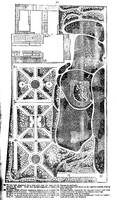234. One of the most beautiful villas in the neighbourhood of Paris, as far as regards general scenery, and views beyond the boundary, is the park of M. Ternaux, at St. Ouen (fig. 63.). The proprietor is well known as a manufacturer, an agriculturist, and an enlightened and philanthropic man. He is highly esteemed by us, not only as a man of taste, but as one of the warmest advocates for universal education in France. His park is not large, and contains little variety of surface; but it is situated on the high bank of the Seine, where that river makes one of its most beautiful bends; and this, with the great extent of varied scenery beyond, are seen to admirable advantage from M. Ternaux's house and grounds. The chief merit of the place consists in the adaptation of the scenery within the boundary to the most beautiful parts of that which lies beyond it; and more especially to the finest parts of the river. For the latter purpose, M. Ternaux has formed two pieces of water (16 and 17) which harmonise with the river, in a manner so striking as to make it difficult to convey by description a clear idea of the effect produced. This striking and harmonious effect was the more difficult to obtain, from the river being there upwards of fifty feet below the surface of the garden, M. Ternaux, however, fixed on a glimpse of the river caught in the distance, and by the two ponds before mentioned (16 and 17), between which, and the distant water, the eye does not meet with the slightest interruption, not even grass or gravel, the distant reach is in effect brought home to the drawing-room windows. To understand how this is done, it is necessary to know that the pond nearest the eye (17) is full to the brim, and from the house (2) carries on the eye to the farther pond (16), which, being higher than all the trees between it and the boundary, and at the same time brimfull, connects it in perspective with the distant reach of the river. The merit of this arrangement belongs entirely to M. Ternaux, who had no professional assistance whatever. The following are the details of the plan: � 1, Manufactory, storehouses, workshops, stables, and other offices and lodgings for the overseers. Mansion. Kitchen-garden. 4, Orangery. 5, Stove. 6, Place for the cheval de bois (roundabout). 7, 7, Platforms of turf, surrounded by lime trees, clipped architecturally, forming airy shady walks. 8, Place for the balancoire (swing). 9, Bergerie (sheep-houses). M. Ternaux has a large flock of merinos, which are housed here every night throughout the year; and every day, when the ground is not covered with snow, or the rain is not excessive, they are taken out, to feed upon, and walk over an extensive tract of common field land, so as to imitate the treatment they receive in Spain. There is also a flock of Cachemire goats lodged with the sheep, and treated like them. M. Ternaux manufactured the finest cloth from the wool of the sheep, and cachemire shawls from the hair of the goats. The flock of goats and the shawl manufactory have, we believe, subsequently been given up. Sheep-house, with dovecot over. Moss-house. 12, Rustic temple. Rock, with an archway and walk underneath. Chinese temple. Parterres. 16 and 17, Ponds connected by a rivulet. Bridge. Rockwork and rustic seat. Artificial spring and rocks. The water that enters by this spring comes from the manufactory (1) to which it is raised from the Seine for various useful purposes. Two Doric columns, surmounted by marble statues. 22, Terrace walk supported by a lofty wall, near the base of which is the Seine. From this terrace magnificent views are obtained. 23, Avenues, chiefly of horse chestnuts, clipped, so as to form columns joined by arches. The soil being dry and gravelly, the trees are very prolific in nuts, which were eaten greedily by the goats, as well as the leaves of the chestnut and other trees, when properly dried, and stacked up for winter use. Statues on pedestals. Lawn sprinkled with shrubs in the natural manner, sloping from 17 to 16. 20, Elevated lawns, planted in the natural manner, and kept verdant and close in summer by nightly waterings. 27, Shady winding walks a l'Anglaise. 28, Point shaded by trees, from underneath which the master-views of the place are obtained.

